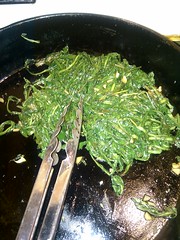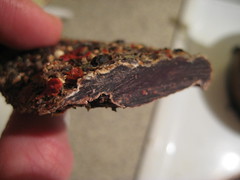recipe: now is the time to eat your lawn
 Every spring, for the past several years, I've been telling myself: "Mark, eat the dandelions in your yard. They're so good for you and I bet they taste great. The co-op is selling them for $3.00 a bunch!" It's a fleeting thought that evaporates with the summer heat, when the dandelions morph from almost-pretty spring flora into desolate, dried-up, seed dispersing weeds. With a new baby and toddler in the house, my approach to lawn care has dropped to historically low levels, if it can be considered "care" at all. The upside is that my small city lot is, quite honestly, a dandelion farm. During times of famine, Italian schoolchildren were sent to the fields to gather wild greens, so why not harvest some from your (chemical free) yard?
Every spring, for the past several years, I've been telling myself: "Mark, eat the dandelions in your yard. They're so good for you and I bet they taste great. The co-op is selling them for $3.00 a bunch!" It's a fleeting thought that evaporates with the summer heat, when the dandelions morph from almost-pretty spring flora into desolate, dried-up, seed dispersing weeds. With a new baby and toddler in the house, my approach to lawn care has dropped to historically low levels, if it can be considered "care" at all. The upside is that my small city lot is, quite honestly, a dandelion farm. During times of famine, Italian schoolchildren were sent to the fields to gather wild greens, so why not harvest some from your (chemical free) yard?
This reality most certainly keeps my neighbors up at night, but they're missing out. In fact, they're likely chatting, nervously, about my lawn over a bag of pre-washed lettuce from sunny California. At this time of year, at least in MN, the dandelions are lush and tender, the flower heads just beginning to emerge. Dandelion greens are a great substitute for spinach or arugula, so you can prepare them as you would any other dark leafy green, such as chard, kale, collard green, etc. They even taste great in a salad with vinaigrette.
recipe: sautéed dandelion greens
In recent months I've resorted to increasingly minimalistic techniques to put fresh food on the table quickly, while keeping two little ones out of trouble. Consequently, this recipe doesn't break any new ground, but it will give you an idea of how easy it is to prepare utilitarian sautéed greens, which make an excellent first course, side dish, or leftover ingredient for other dishes like omelets and quiches. It's also an excuse to put down the laptop and weed your yard or garden.
Note: Like spinach, dandelion greens will wilt to a mere fraction of their initial volume, so you can cook a lot of them at once. Just make sure you have enough of the other ingredients to season them well.
Ingredients
- One large bunch of trimmed, washed, and roughly chopped dandelion greens (two big fistfuls)
- 2 cloves of garlic, thinly sliced
- olive oil
- balsamic vinegar
- red pepper flakes (optional)
- coarse salt and freshly ground pepper
- Heat a few tablespoons of oil in a skillet. When smoking, add the garlic and optional red pepper flakes. Cook until garlic is very fragrant (but not brown), about 30 seconds.
- Add the greens and stir them quickly as they wilt. Cook until greens are still bright in color, but quite tender (3-5 minutes).
- Add a few splashes of balsamic vinegar (to taste), season with salt and pepper, and serve immediately.





